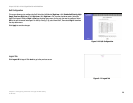
28
Appendix B: Cabling
Overview
24-port 10/100 + 2-Port Gigabit Switch with WebView
Appendix B: Cabling
Overview
Twisted Pair Cabling and Fiber Optic Cabling are discussed in this appendix.
Twisted Pair Cabling
There are different grades, or categories, of twisted-pair cabling. Category 5 is the most reliable and is highly
recommended. Straight-through cables are used for connecting computers to a hub. Crossover cables are used
for connecting a hub to another hub (there is an exception: some hubs have a built-in uplink port that is crossed
internally, which allows you to link or connect hubs together with a straight-through cable instead).
You can buy pre-made Category 5 cabling, or cut and crimp your own. Category 5 cables can be purchased or
crimped as either straight-through or crossover cables. A Category 5 cable has 8 thin, color-coded wires inside
that run from one end of the cable to the other. All 8 wires are used. In a straight-through cable, wires 1, 2, 3, and
6 at one end of the cable are also wires 1, 2, 3, and 6 at the other end. In a crossover cable, the order of the wires
change from one end to the other: wire 1 becomes 3, and 2 becomes 6. See the diagrams on the next page for
more detailed information on straight-through and crossover cabling.
To determine which wire is wire number 1, hold the cable so that the end of the plastic RJ-45 tip (the part that
goes into a wall jack first) is facing away from you. Face the clip down so that the copper side faces up (the
springy clip will now be parallel to the floor).When looking down on the copper side, wire 1 will be on the far left.
Crimping your own Network Cables
The processes for straight-through cabling and crossed-over cabling are illustrated below.
Figure B-1: Cable Charts


















